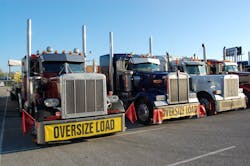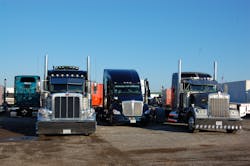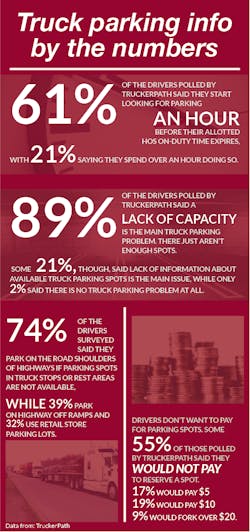So how bad is the truck parking problem in the U.S.? Well, that depends on who you ask. Some truck drivers say it’s impossible to find parking spots on a daily basis; others, however, say it’s easier than many think—especially if you use technology to help find open slots.
That’s the stumbling block when it comes to dealing with the issue of truck parking: While there’s a lot of anecdotal evidence about how hard it is to find available spots, and while there are plenty of state-level reports delving into the issue, it is proving difficult to craft a single “big picture view” of the shortage of truck parking. What’s even tougher, though, is dealing with the fallout from the failure to locate adequate and safe truck parking, particularly for drivers.
Tisha Keller, vice president of the Florida Trucking Association in Tallahassee, FL, highlighted the “fallout” from one particular problem spot along the I-4 corridor, where many neighborhoods abutting this major highway are opposed to creating more parking spaces for commercial vehicles.
“Because the rest area on I-4 is the only rest stop in that area, all trucks park there,” she explained, adding that as the area begins to overflow, highway patrolmen push truckers out.
“The driver says: ‘Where am I supposed to go? I’m out of hours, and I’m supposed to stop,’” she stressed.
Because of such circumstances, many truck drivers resort to what Keller described as “unsafe and illegal methods” of parking, such as on the shoulder of a highway on/off ramp or in vacant lots.
After conducting a study with Florida International University to assess parking lot utilization and technology use, the Florida Dept. of Transportation (FDOT) found the biggest problem statewide is an imbalance of truck parking capacity due to a lack of parking information management, with the agency finding that such parking “overflow” can occur at some locations while others remain underutilized.
One reason for such “unevenness” in truck parking capacity stems in part from traffic congestion trends.
“Truck parking and traffic congestion—these issues are linked,” Rebecca Brewster, ATRI president and COO, explained, noting that truck parking is “a top research priority” for the group this year.
“The hypothesis is if drivers had more flexibility in terms of hours-of-service rules and available parking places, would they be able to make the decision not to drive in the most congested locations during the most congested times of the day? Yet making that decision relies in part on parking options,” she said.
Brewster added that “there is no question” that sitting in traffic is a fatigue-causing experience and that the ability to rest and recover from it requires a place for a driver to park his or her tractor-trailer for a significant and undisturbed length of time.
“Parking is definitely tied to the traffic congestion issue,” she pointed out.
Brewster also emphasized that “we really are getting to the ‘perfect storm’” in terms of the problems posed by traffic congestion and the lack of adequate truck parking.
“High consumer demand [for goods] means more vehicles on the road. While that is great for our industry, the current infrastructure can’t handle the traffic situation we have here now,” she explained. “We need to focus on improving and expanding [roadway] infrastructure.”
That also means expanding truck parking capacity, but where?
To get a clearer national-level view of that issue, mobile app developer TruckerPath, Austin, TX, compiled a report analyzing the truck parking problem from a driver’s perspective.
Based in part on 5.5 million data points crowdsourced through its mobile service, along with a survey of 3,300 truck drivers who are members of its online community, TruckerPath’s report highlights how much the problem is costing drivers and fleets as well as other negative “side effects” being generated by this issue.
Ivan Tsybaev, founder and CEO of TruckerPath, noted in the report that finding safe truck parking for drivers is a “critical issue plaguing the trucking industry, affecting driver earnings, safety, and productivity while also affecting fleet revenues.”
Based on his company’s data analysis, Tsybaev said “it’s nearly impossible for a driver to find parking within 45 minutes during evening hours.” Many drivers lose an estimated 11 hours per month searching for truck parking, which amounts to about $600 in lost wages and an additional loss of $60 in profit for the fleet. That’s about $8 million annually for a fleet of 1,000 drivers.
TruckerPath also discovered that 79% of drivers it polled are forced to violate hours-of-service rules because they could not find parking.
Sam Bokher, head of marketing for TruckerPath, explained that the company felt the need to delve into the truck parking problem because it’s a top stress point for drivers, yet there is little national data about it—and that data is key to solving the problem, he emphasized.
That’s why TruckerPath’s report overlays its data on top of a roadway map of the U.S., illustrating where the “trouble spots” for truck parking are—with most of those “trouble spots” mainly in Western U.S. locations.
“We’re trying to take a ‘holistic view’ with this data so we can maximize the impact of capacity additions,” Bokher added.
Forcing drivers to search for parking—61% in TruckerPath’s survey say they spent an hour a day doing so—not only reduces “equipment utilization,” Bokher said, but “creates economic impacts for motor carriers, freight brokers, and shippers.”
Bokher also stressed that this isn’t just about reducing the economic costs associated with lost truck productivity and fuel wasted in the search for parking. It’s also about driver safety, a point addressed in part by Jason’s Law, which was passed by Congress five years ago, he noted.
For example, TruckerPath’s survey found that 74% of the drivers it polled said they park on the road shoulders of highways if truck stop or rest area parking isn’t available, while 39% park on highway off ramps and 32% use retail store parking lots.
That’s exposing them to risks—and not just life and limb. According to TruckerPath research, 19% of the truck drivers it polled said their personal belongings were stolen from their truck because of the lack of safe parking and being forced to stop overnight at “unauthorized locations” that are not monitored.
And that’s before the threat of cargo theft is rolled into the picture: a $35 billion to $40 billion annual problem in the U.S., according to the FBI.
With so many issues tied to the problem of truck parking, it is TruckerPath’s hope that the data generated with this report will be tapped by government agencies and others to help pinpoint the areas most afflicted by shortages so they can be tackled first.
‘Jason’s Law’ helping the cause
Over five years ago, the U.S. Congress and then-President Barack Obama brought Jason’s Law into being as but one small part of the Moving Ahead for Progress in the 21st Century Act, or MAP-21, the complicated name for omnibus highway funding legislation passed in June 2012.
The law got its name from the robbery and murder of truck driver Jason Riverburg in a remote abandoned gas station just 12 miles from his next morning’s delivery point.
The receiver of his load didn’t permit truckers to park at its facility overnight and the truck stops in the area were all full, so Jason parked in an abandoned gas station. He had heard through other truckers that this was a safe place to park overnight.
That turned out to be bad information, however, with Jason murdered for the measly $7 in his pocket — a victim of being in the wrong place at the wrong time. To compound this tragic tale, Jason left behind a wife pregnant with twins and a two-year-old son.
To try and prevent these types of situations from occurring again, the law that bears his name directed the U.S. secretary of transportation to do several things:
• Implement a pilot program to allocate funds to states, metropolitan planning organizations, and local governments that submit an application approved by the secretary for eligible projects to establish long-term parking facilities for commercial motor vehicles on the National Highway System.
• Give priority to applicants that demonstrate a severe shortage of truck-parking capacity and whose proposed projects are likely to have positive effects on highway safety, traffic congestion, or air quality.
Yet despite passing the fifth anniversary of Jason’s Law, safe parking continues to be a major issue for truckers. One just hopes it won’t take another terrible incident similar to Jason Riverburg’s to help speed up the development of solutions to the U.S. truck parking problem.
—Tim Brady
About the Author
Sean Kilcarr
Editor in Chief
Sean Kilcarr is a former longtime FleetOwner senior editor who wrote for the publication from 2000 to 2018. He served as editor-in-chief from 2017 to 2018.



